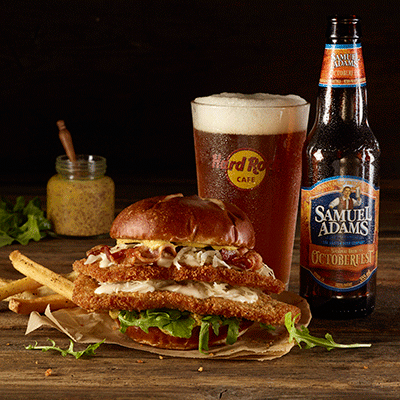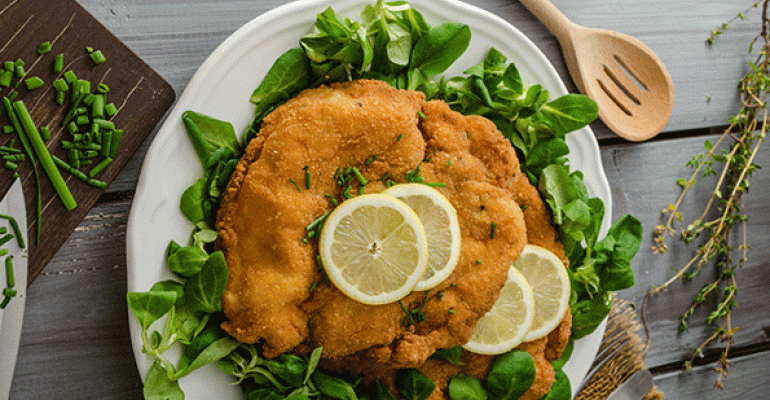There’s been a rediscovery recently in American restaurants of Teutonic classics like schnitzel and spätzle. It follows the New Nordic trend that shone a spotlight on the cuisines of Northern Europe, and it also reflects the creativity of a younger generation of chefs who are willing to tinker with tradition by adding contemporary touches.
Schnitzel is German for cutlet, the slice of meat that’s typically dipped in egg before being dredged in breadcrumbs and pan-fried. Wienerschnitzel, as its name indicates, originated in Vienna (the German name for Vienna is Wien), and it’s made from veal, though many Germans substitute pork. Modern interpretations are likely to forgo both in favor of alternate proteins like chicken. Great examples abound in Atlanta, which is in the midst of a schnitzel storm. Seed Kitchen’s chicken schnitzel gets extra depth of flavor from miso mustard and oven-dried tomatoes, while 1Kept’s version is accompanied by caramelized onion cream. Tom Tom’s chicken schnitzel is simply served with mixed greens, but Seven Hens pushes the envelope with seven globally-inspired chicken-schnitzel sandwiches such as curry cucumber, ginger teriyaki and chipotle cilantro. Similarly, New York City’s Schnitz goes to town on chicken-schnitzel sandwiches with unexpected options like the Caesar Schnitz, which has black kale Caesar salad Grana Padano cheese and a fried egg. And Naf Naf Grill, a Chicago-based fast-casual chain specializing in Middle Eastern cuisine, puts its chicken schnitzel on a platter or in a pita with hummus, tahini and Israeli salad.

Other operators have taken a more traditional tack by using pork schnitzel, albeit in unexpected presentations. Hard Rock Cafe’s special last fall was the Samuel Adams OctoberFest Schnitzel Burger, in which pork schnitzel was topped with beer-cheese sauce, smoked bacon, sauerkraut, whole grain mustard and arugula on a pretzel bun. Tasty n Alder in downtown Portland, Ore., features pork schnitzel for brunch, with a sunny side-up egg, ham, Havarti cheese and mustard-braised cabbage, while Publican in Chicago plays a variation on that theme with its brunch special of pork schnitzel with grits, banana peppers and eggs. Some restaurateurs are tapping into the vegetable trend, as with Schnitzel & Things, a food truck in New York City, which dishes up Eggplant Schnitzel, a kind of first cousin to the more familiar Milanese version. Also in New York, Little Park rode the root-vegetable boomlet with a celery root schnitzel sandwich topped with homemade Pommery mustard, Brussels sprouts and pickled-apple slaw.
Spätzle is German for “little sparrow,” a reference to the appearance of the tiny, flour-and-egg-based dumplings. A time honored side dish over there, it’s appearing all across the menu here. At Nashville’s Josephine, spätzle with ramps, bacon & whole-grain mustard is an entrée, while at Brooklyn’s Prime Meats, herb and Gruyère spätzle is an appetizer. At Freud in New York City, dark rye spätzle with cheddar and cauliflower is on the small plates menu. Story, located outside of Kansas City, jumped geographic boundaries with Campo Lindo Chicken Breast with roasted black plums, huckleberries and almond spätzle, and Rhein House in Denver is equally creative with its sweet potato-celery version. But other operators hew somewhat closer to convention. Philadelphia’s 26 North BYOB serves truffle spätzle as a side dish with skate wing, and Chicago’s The Radler dishes up cheesy spätzle alongside pork loin schnitzel.

Sauerkraut is German for sour cabbage, a humble item enjoying a second wind bolstered by revived interest in fermented foods as well as the product’s characteristic sour taste — a flavor dimension that’s been coming into vogue with American diners. Operators are riffing on its association with classic sandwiches. &pizza, a fast-casual chain based in Washington, D.C. created the Reuben Pizza with all the requisite ingredients: Pastrami, sauerkraut, Thousand Island dressing, Swiss cheese and cole slaw. Another unexpected take on tradition is the Pastrami Tacos from Eloisa in Santa Fe, N.M., in which blue-corn tortillas are filled with pastrami, sauerkraut and pickled Serrano peppers. Schweinehaus in Memphis taps into the burger boom with a signature burger topped with cheddar, bacon, sauerkraut, arugula and maple whole-grain mustard. And sauerkraut is a poppable finger food at Brauhaus Schmitz in Philadelphia, where the Sauerkraut Kroketten, or sauerkraut croquettes, are served with sausage, cheese and mustard sauce.
Nancy Kruse, president of the Kruse Company, is a menu trends analyst based in Atlanta. As one of Linked In’s Top 100 Influencers in the US, she blogs regularly on food-related subjects on the Linked In website.





